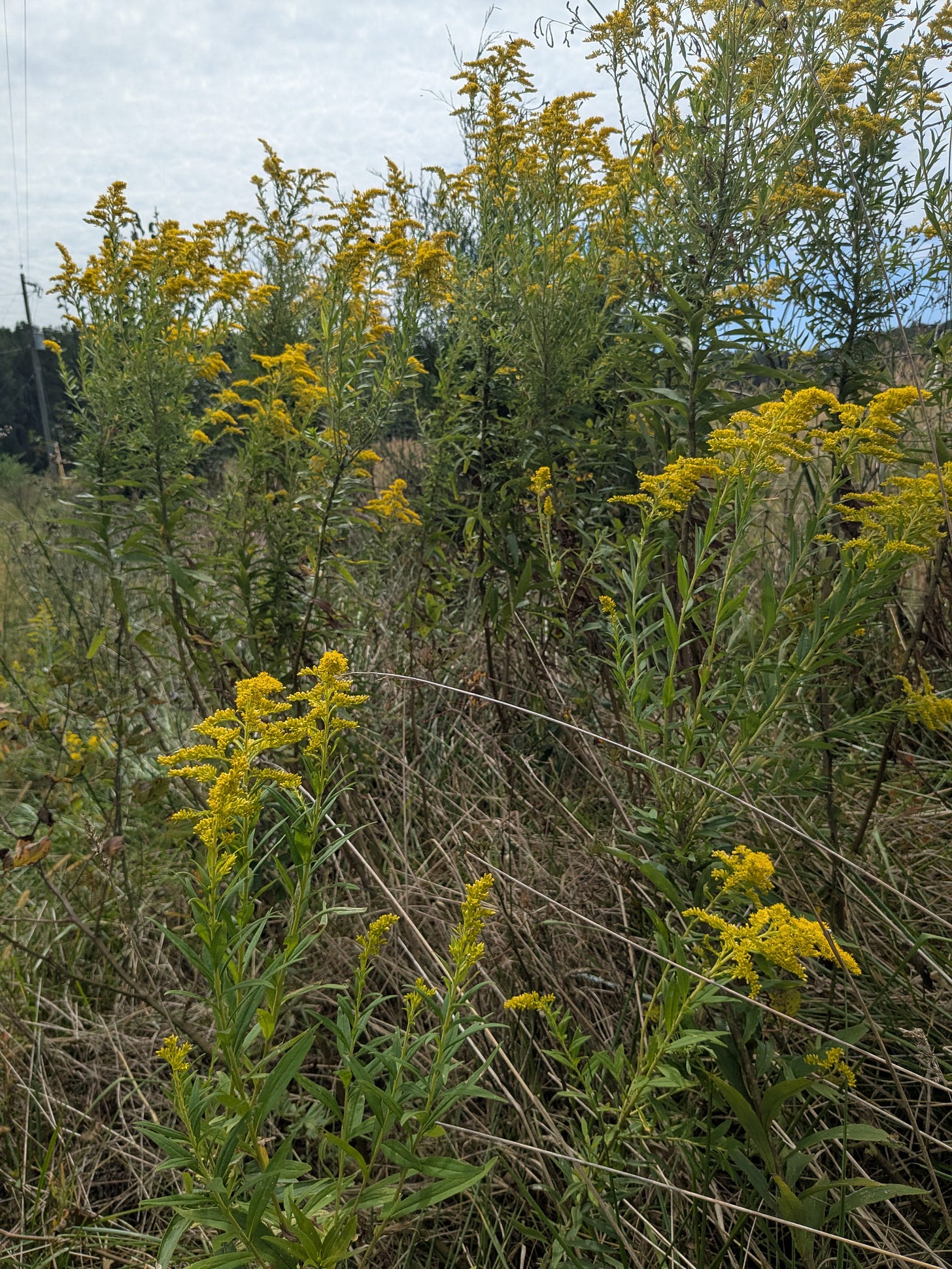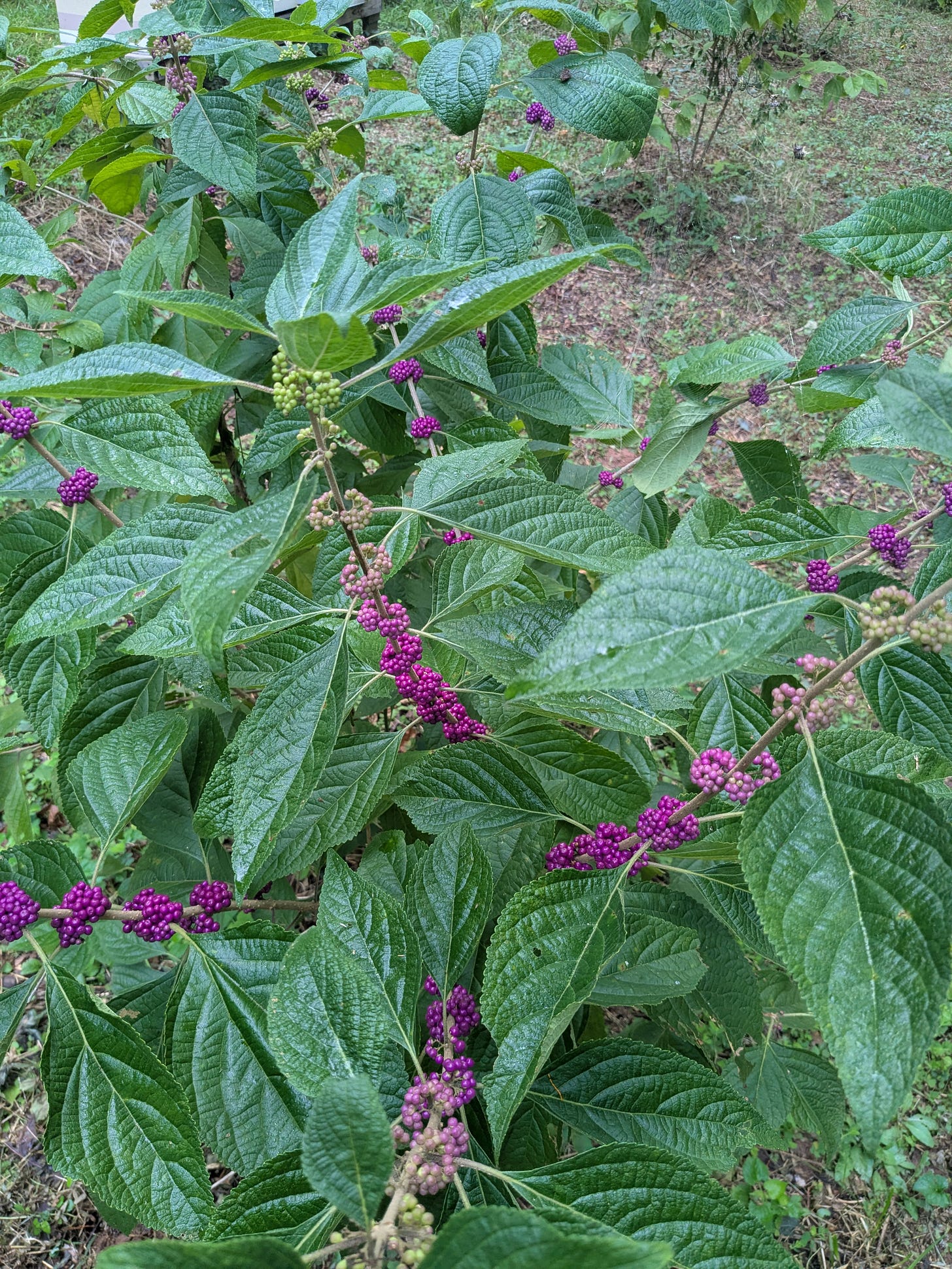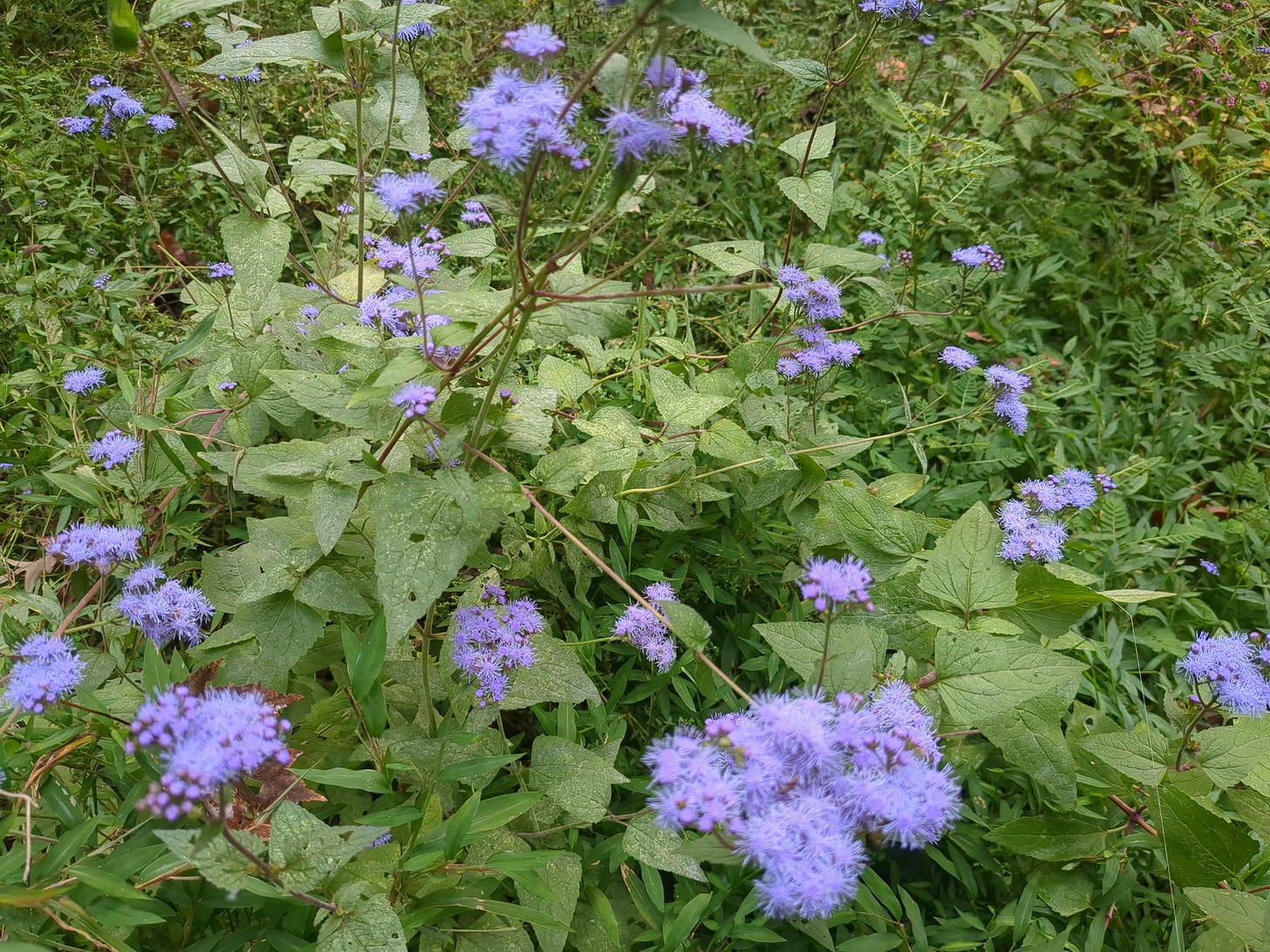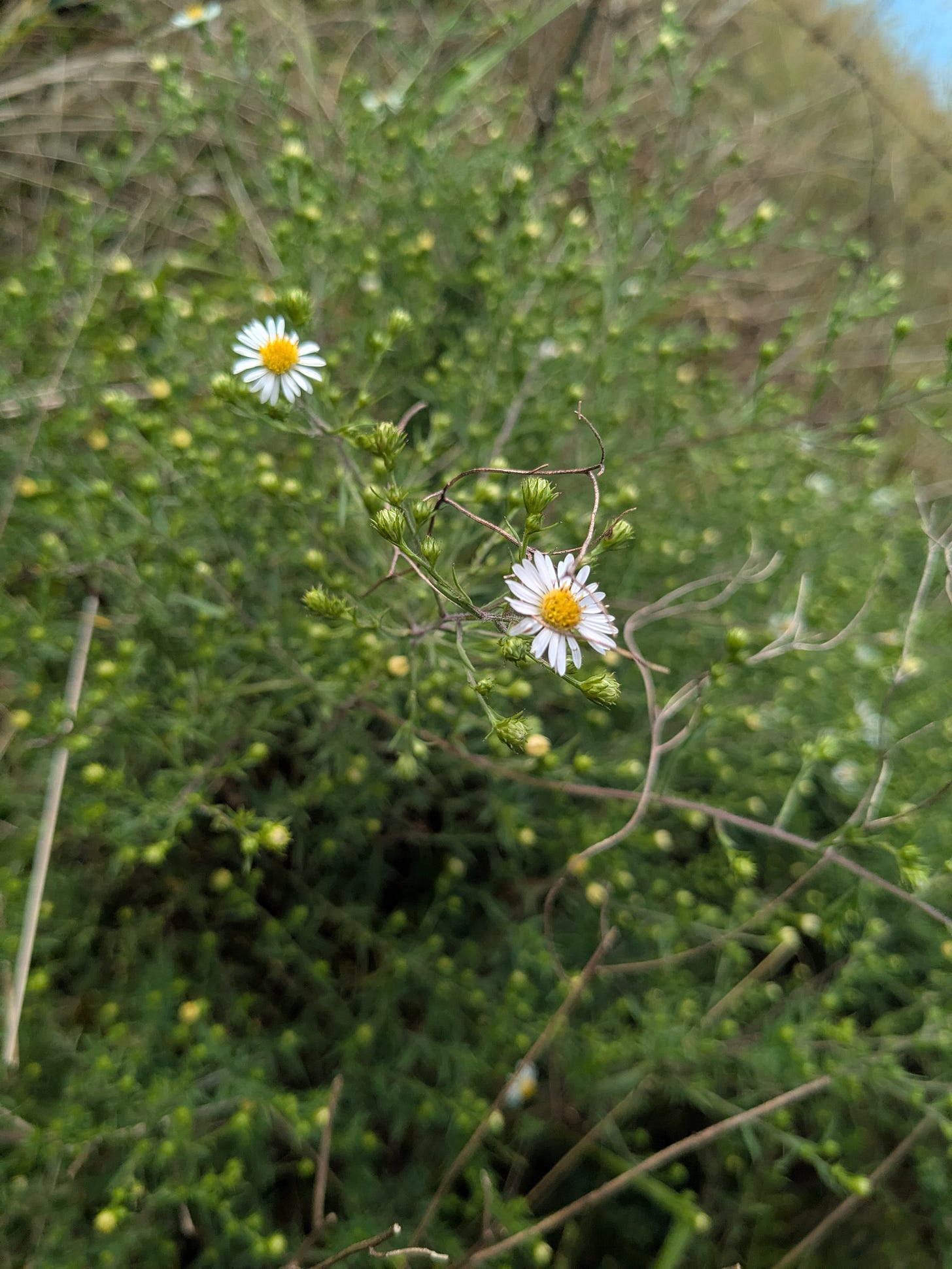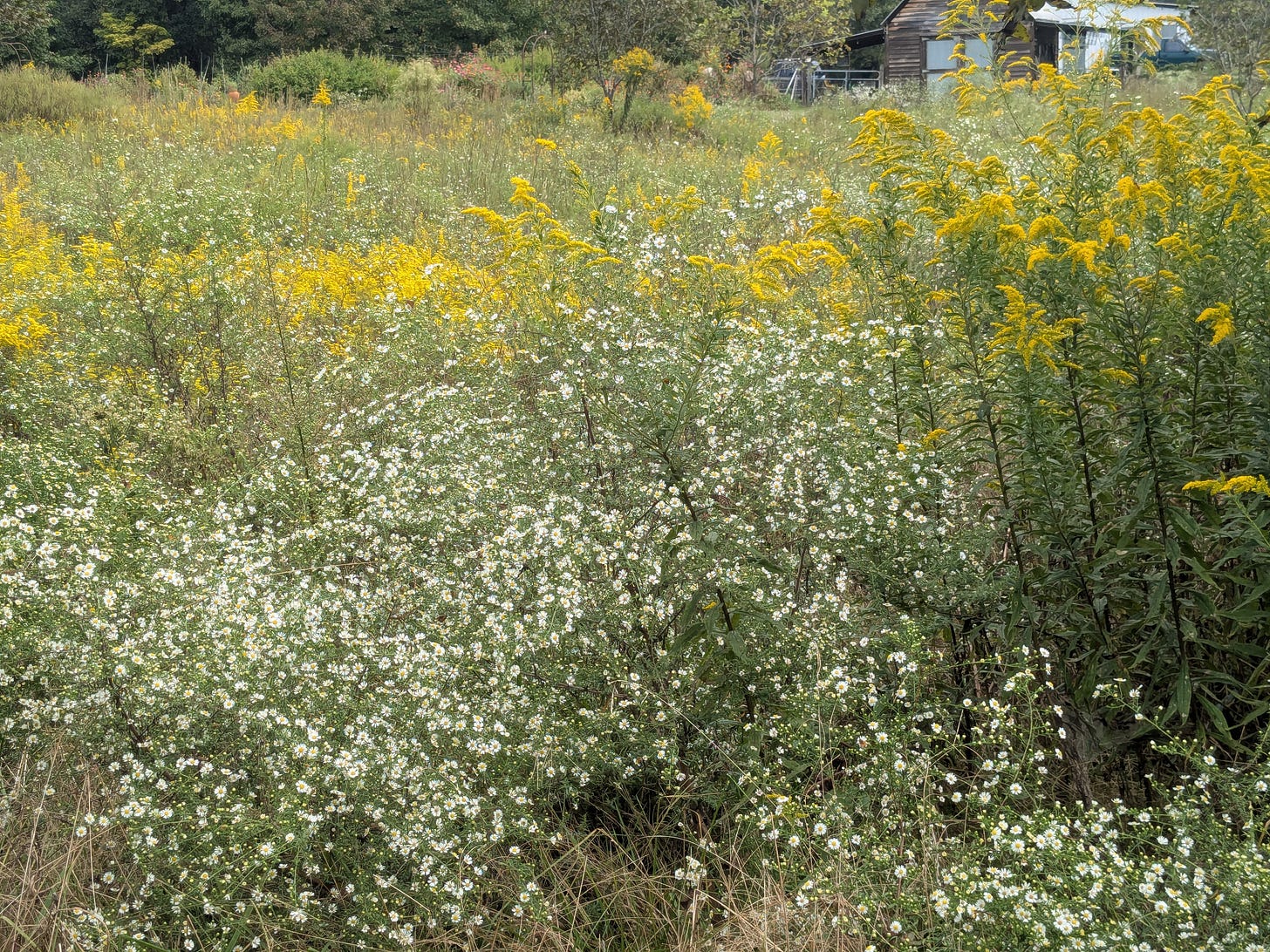Seeing September
In the Ditch
The Tuft of Flowers By Robert Frost I went to turn the grass once after one Who mowed it in the dew before the sun. The dew was gone that made his blade so keen Before I came to view the levelled scene. I looked for him behind an isle of trees; I listened for his whetstone on the breeze. But he had gone his way, the grass all mown, And I must be, as he had been,—alone, ‘As all must be,’ I said within my heart, ‘Whether they work together or apart.’ But as I said it, swift there passed me by On noiseless wing a ‘wildered butterfly, Seeking with memories grown dim o’er night Some resting flower of yesterday’s delight. And once I marked his flight go round and round, As where some flower lay withering on the ground. And then he flew as far as eye could see, And then on tremulous wing came back to me. I thought of questions that have no reply, And would have turned to toss the grass to dry; But he turned first, and led my eye to look At a tall tuft of flowers beside a brook, A leaping tongue of bloom the scythe had spared Beside a reedy brook the scythe had bared. I left my place to know them by their name, Finding them butterfly weed when I came. The mower in the dew had loved them thus, By leaving them to flourish, not for us, Nor yet to draw one thought of ours to him. But from sheer morning gladness at the brim. The butterfly and I had lit upon, Nevertheless, a message from the dawn, That made me hear the wakening birds around, And hear his long scythe whispering to the ground, And feel a spirit kindred to my own; So that henceforth I worked no more alone; But glad with him, I worked as with his aid, And weary, sought at noon with him the shade; And dreaming, as it were, held brotherly speech With one whose thought I had not hoped to reach. ‘Men work together,’ I told him from the heart, ‘Whether they work together or apart.’
With its [Purple Grass (Eragrostis pectina cea)] beautiful purple blush it reminds me, and supplies the place, of the Rhexia [Meadow Beauty], which is now leaving off, and it is one of the most interesting phenomena of August. The finest patches of it grow on waste strips or selvages of land at the base of dry hills, just above the edge of the meadows, where the greedy mower does not deign to swing his scythe; for this is a thin and poor grass, beneath his notice. Or, it may be, because it is so beautiful he does not know that it exists; for the same eye does not see this and Timothy. He carefully gets the meadow hay and the more nutritious grasses which grow next to that, but he leaves this fine purple mist for the walker’s harvest,— fodder for his fancy stock.
–Thoreau, Autumnal Tints
I first discovered this Frost poem shortly after I had gotten a scythe. Scythes are elegant tools, bespoke based on height, hip to ground, and cubit (elbow to fingertip), with the fundamental expectation of long use in the field and the need for precision. I have two blades, one long and light for mowing grass or grain, one shorter and more stocky for mowing ditches. It is my preferred tool for mowing around my honey bee hives; truth to tell, it is the bees’ preferred tool as they hate the noise and exhaust of mowers. When I mowed the apiary with an internal combustion engine, I was without fail chased away by angry bees. With the gentle whispering scythe, I can mow right up to the hives and not disturb the bees. I can leave behind, as well, the array of plants that I and the bees love to have about. The apiary now grows a number of lovely beauty berry shrubs, all saved by the scythe.
I have never known a world in which industrial mowers didn’t manage the roadsides. It is not their calling to indulge in the serendipity of saving a bloom. This poem captures a moment all but impossible to imagine today: a tuft of butterfly weed purposefully left behind by a mower, its bright orange blooms calling the migrating monarchs. The grand interruption the poem offers is predicated on the communion of narrator and butterfly: with butterfly as guide, the narrator, here turning the cut grass to dry before bailing, sees with new eyes, hears with new ears, his eyes and ears now one with this humble beauty, a beauty that inspires a new level of human community.
In like manner, Thoreau’s Autumnal Tints calls us to turn our eyes and minds to a beauty redefined by wildness, by that which is left behind as too little or of too little value. I have been stalking beauty this September mostly in the ditches where the mower “does not deign to swing his scythe,” along the fences graciously left in their wild estate, and in the abandoned railroad cut left to its own devices. The blue mist flowers tucked back in quiet corners can call me in for meditation and demand an extended visit. I linger with the small white asters too. Most of all, it is the goldenrod that owns my fancy this season; it is this walker’s favorite harvest and fodder for my fancy stock.
The particular beauty I seek is counter to the culturally cultivated, foreign to the civil and hybridized, decidedly un-exotic; rather, it is native, common, and wild. Many would say I, like Thoreau, am unduly infatuated with weeds, and I suppose they would be correct. This September’s beauty will never grace the covers of magazines or be sent out old-school on postcards to friends and family; it will not be the stuff of viral Instagram posts, for it is essentially an ephemeral beauty, of the moment, in the fullness of time, outside of insistent clocks and tyrannical calendars. This beauty interrupts time as it interrupts me.
The beauty I seek this fall is in the avatar of goldenrod on sun-soaked afternoons when the honey bees are abuzz on these wonders, happily taking a touch of sunshine home to the hive in the form of pollen and nectar. It is a seasoned moment, a perfect ripeness like that of a cantaloupe letting go of the vine.
I have a young friend who is practiced in the art of herbalism. I have regularly quizzed her since she first began her study of potions and have tinctures of her making in my pharmacy. When I asked her about goldenrod, she bloomed like the plant itself, glowing with enthusiasm. “Its nature is counter-intuitive,” she noted, “as many think it causes allergic reactions when it rather serves as a cure.” This stubborn ditch weed that most folks purposefully mow, she cultivates, her yard gloriously exploding in September gold. She has placed it in bridal bouquets so that the bride carries sunshine and wholeness to the altar. I’m quite sure her young children, raised to be one with the soil and sun, know goldenrod by name and dance about their favorite patches of lance-shaped leaves topped with long arms of sunshine. They reenact sun rituals intuitively. They have been well seasoned.
As I do, she places vases of goldenrod on her table to bless the household; my writing desk currently wears a dusting of pollen and a dotting of tiny seeds beneath the declining plumes. She encouraged me to add a tuft of goldenrod to my daily cup of Tulsi tea so that I might regularly imbibe its gifts, a practice I have begun. Along with the dose of sun, the two stems of goldenrod add a hint of the bitterness of the season to the tea that reminds of the end of summer, of loss and death.
Goldenrod, as my honey bees know well, is a keystone species, one essential to the health of the ecosystem, perhaps the most important plant in North America for pollinators in fall. There are generally two nectar flows for honey bees in the Georgia Piedmont. The primary flow is in April and May when it seems the whole world is in bloom. The secondary flow comes, if at all, in September and consists mostly of asters and goldenrod. The smell of the hive is distinct; the returning bees’ pollen sacks bulge with yellow-orange goldenrod pollen. The fall flow is the season where I most regret the county’s mowing of the ditches on our dirt road—so much bee food laid to waste.
This year, September has been delightfully sunny and thus a delightfully good season for gathering pollen and nectar. I have spent many afternoons watching the bees come home with their bounty. I have lingered by patches of goldenrod and aster, the bees busy on the blooms. As Thoreau notes in his “Natural History of Massachusetts,” “Nature will bear the closest inspection; she invites us to lay our eye level with the smallest leaf, and take an insect view of its plain. She has no interstices; every part is full of life.” Thus I lay my eyes and see a kind of ecosystem beauty, an abundance found at the margins of our cultivated life, of endless miniature blooms on flowers found in a ditch, embraced by bees with their hairy bellies dusted gold. At the end of the season, I will take from the bees a modest portion of this abundance; thus, with each taste of honey I enjoy in winter, I will remember these bees on these plants in this sunshine on this wonderful September afternoon.
The Community of a Fig Tree
On that day, says the Lord of hosts, you shall invite each other to come under your vine and fig tree.”
-- Zechariah 3:9-10
On a hot summer day in August of 2020, the figs on our farm, in riotous abundance, called me and many of the more than human world to enjoy the bounty. Sitting under the shade offered by the luscious leaves, I fell into a reverie at least in part inspired by the heat, the fermenting figs, and the buzz of 10,000 honey bees. My reflection on this reverie became the first chapter of A Book of Season (https://www.abookofseasons.com), which will be published by Mercer University Press in May of 2026. Watch this Substack for information on how to order.


